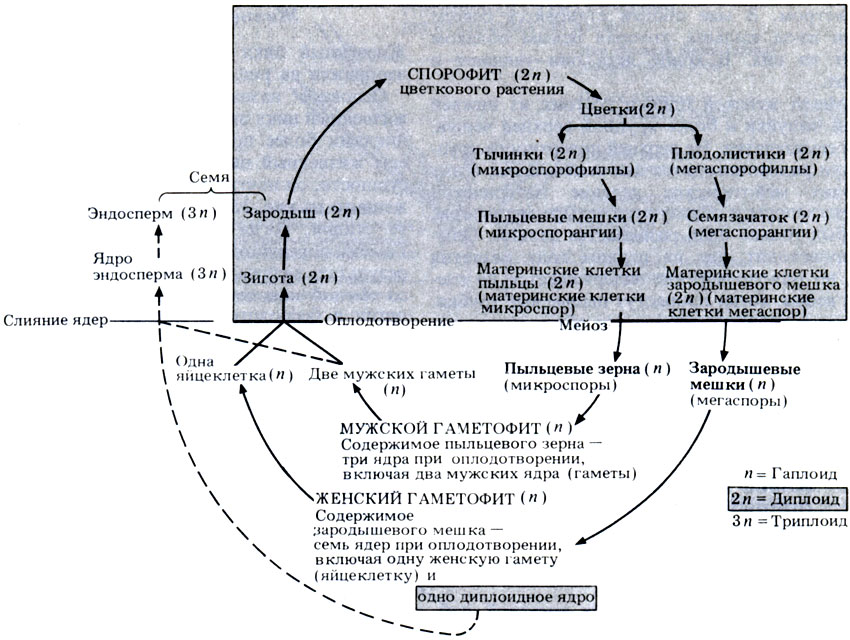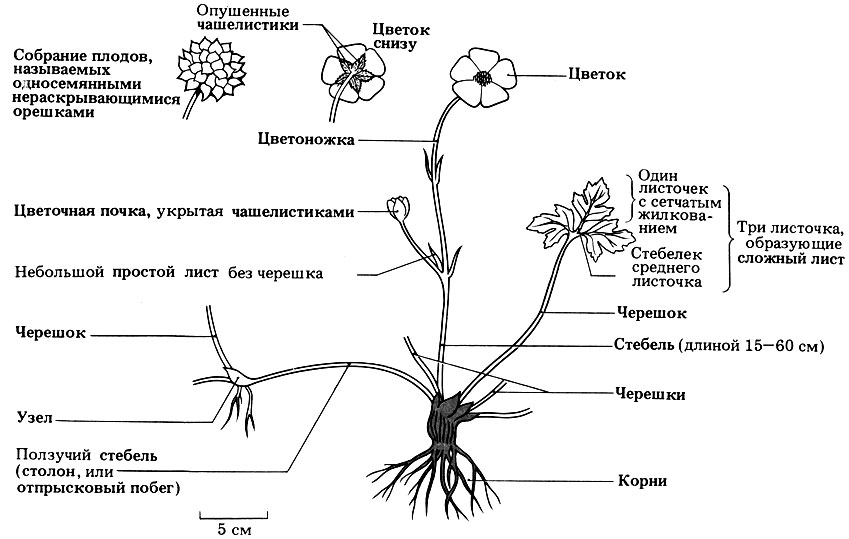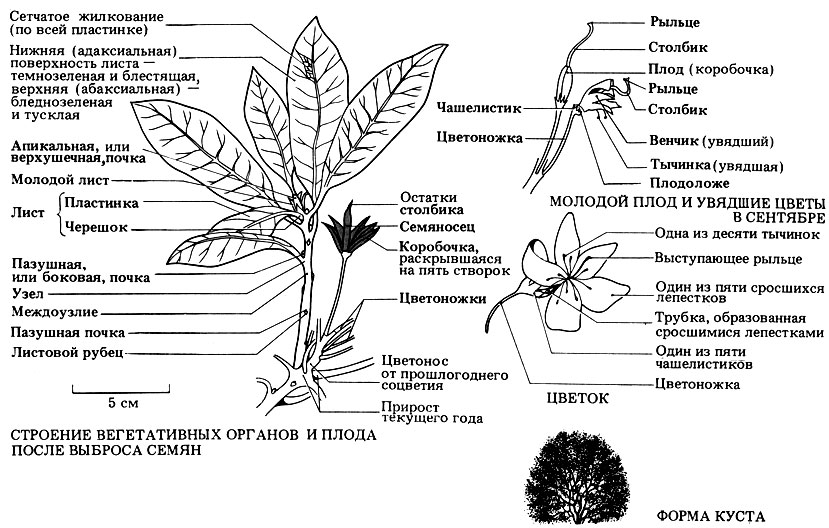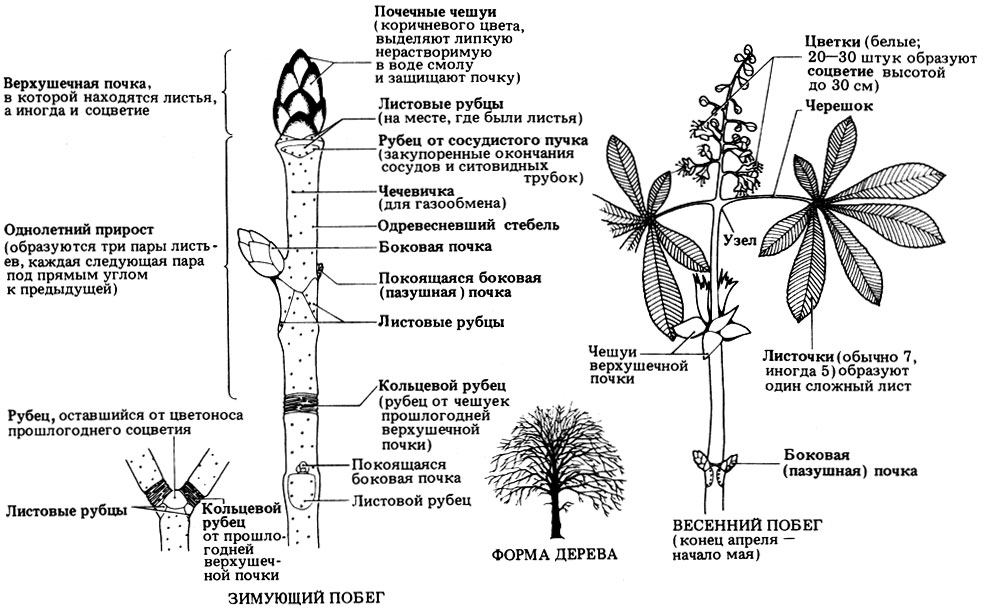3.5. Department Spermatophyta - Seed Plants
SPERMATOPHYTA (Greek. Sperma - Seed) is the most prosperous group of terrestrial plants. In this section, we focus on the adaptation adaptations of seed plants that contributed to their prosperity, and, moreover, compare them with lowerly organized groups that we have already considered.
Seed plants apparently occurred from extinct seed fern. If you recall Selaginella (as one of the representatives of fern), it should be noted that it is essentially the same life cycle as in seed plants; The only difference is that Selaginella has a female Gametophyte Avtotrophen, and in seed plants it loses autotrophiness. However, let's forget about Selaginell and try to compare the life cycle of seed plants and equalidate fern (ordinary ferns).
One of the main difficulties facing plants on land is related to the vulnerability of the gametophyte generation. For example, Gametophyte ferns are a gentle stroke, which forms men's gametes (spermatozoa), in need of water to achieve an egg. And at seed plants, Gametofit is protected and very much reduced. Only comparing the life cycles of seed and more primitive plants, it can be understood that the seed plants are stored alternating generations. Seed plants have three very important advantages: 1) Differentiality, 2) the formation of seeds and 3) the appearance of non-paying men's weights.
Differenceness
A very important step on the path of evolution from fern-like to seed plants was the emergence of plants forming the disputes of two types - microspores and megasy. Such plants are called diasporas; They were considered in Section. 3.4. In tab. 3.6 A brief dictionary of terms relating to sporing spores in the life cycle of pavement plants is given (see also Fig. 3.26). All seed plants are sorcerers.
A male gameman develops from the microspiona, and a female Gametophyte arises from Megasport. And in that and in another case, Gamenaophyte is very much reduced and does not come out of the dispute. The exception is freely living independent Gametophyte of equivofor plants, such as Dryopteris. The dispute protects the Gametophyte from drying, which is an important adaptation to life on land. Gametophytes are not capable of photosynthesis, so they need nutrient reserves accumulated in disputes by the preceding spores. As we will see further, the limiting reduction of the gamethophyte is observed in flowering plants.
Megasports are formed in megaloprangies on megaphyllah, and microspores - in microspores on microspofllah. In seed plants, the structure equivalent to megasoprangia is called sumpty. Inside the sick, only one Megaspora is developing, or one female gametophyte called germ sack. The structure equivalent to microsporegia is called pollen sack. In the pollen bag a lot of microspores are formed, which are called pollen grains or dustcasses.
Evolution of Semen
In seed plants, Megaspi are not separated from sporophyte. Unlike the picture that we observe more primitive pavement organisms, Megachers remain inside the (Megasporangiyev) attached to sporophyte. Inside megasport is developing a female gamethophyte (germ bag) and one or more female hamets are formed, or eggs. After fertilization of the female gamete, the sicks are called already semenem. Thus, the seed is a fertilized segue. Summer, and later and seed has a number of benefits:
1. The female Gametophyte is protected by a nexian, entirely depends on the parent sporophyte, but much less sensitive to dehydration than a freely living GaMetophyte.
2. After fertilization, the supply of nutrients obtained by the Gametophyte from the parent spore plant is formed, from which it is still not separated. This stock is used by a developing zygote (the following spore generation) after seed germination.
3. Seeds are adapted to resist adverse conditions, and can remain at rest until the conditions are favorable for germination.
4. Seeds may develop various devices that facilitate their distribution. The seed is a complex structure in which the cells of three generations are assembled - the parent sporophyte, the female gamethophyte and the embryo of the next spore generation. In general, this is shown in Fig. 3.34. Parental sporophytic gives seed all that is needed for life, and only after the seed completely matures, that is, the supply of nutrients for the embryo sprout is separated from the parent sporophyte.
Evolution of non-paying men's weights and fertilization independent of water
For sexual reproduction of plants, which we have already considered, it is necessary that the spermatozoid can swim to the egg, that is, water is needed. Therefore, there are certain problems in front of seed plants. In order to occur in fertilization, men's games must reach women's weights, and, as we have said, male and female games are developing separately, and besides, women's games still remain inside the selfophyte's sorts. Men's gametes are formed by men's gametophytes inside the microspores, or pollen grains. They do not turn into floating spermatozoa, and remain motionless and transferred together with pollen grains from pollen bags (microsprangiyev) to segments. Such a transfer of pollen is called pollination. At the last stage of pollination is formed pollen tubewhich grows towards the satellite; For this tube, fixed men's machines reach eggs, and fertilization occurs. Water does not need sperms in any of the listed stages. Only in some primitive seed plants, such as cigarette, sperm exit from pollen tubes, which indicates a certain relationship with unnecessary plants. In fig. 3.34 Compare life cycles of seed and some unacciated plants. The origin of the seeds and the relationship between the sporophytic and gametophyte generations is particularly highlighted. Pollination may not have any benefit, since this process is purely random nature and is achieved with difficulty, and the formation of a large amount of pollen is biologically unprofitable. It is believed that initially pollination took place only with the help of wind. However, at the dawn of the evolution of flowering plants, the first flying insects appeared (about 300 million years ago, in the coal period). Immediately the possibility of more efficient pollination of insects. One of the groups of seed plants - flowering plants - most successfully uses this opportunity.
3.12. The chances for survival and the emergence of pollen grains (microspores) carrying winds are much smaller than for DRYOPTERIS dispute. Why?
3.13. Explain why Megachers are large, but small microspores.
3.5.1. Basic signs and systematics Spermatophyta
The main signs and systematics of Spermatophyta are presented in Table. 3.8.
| Department Spermatophyta (Seed Plants) | |
|
General signs
Different, i.e. have two types of dispute: microspores and megasy; Microspore \u003d Pollen grain, megaspor \u003d germ bag. A germs bag (megaspora) remains entirely closed in a seed (Megasprangia); The seed is a fertilized segue. Sporophyte dominates; The gametophite generation is extremely reduced. For sexual reproduction, water is not needed, because male games are not able to swim (the exception is some of the most primitive representatives); To fertilize the eggs, they penetrate the ovary through the pollen tube Complicated on the structure conducting tissues in roots, stems and leaves. |
|
| Class Gymnospermae (mainly coniferous; in addition, tissue, coagovy, ginkgy, etc.) | Class Angiospermae (Flowering Plants) |
| The "naked" seeds: This means that the seeds lie openly, that is, not hidden in the wound. | Seeds are hidden in the wound. |
| Usually form cones on which sporangies and disputes appear. | Forming flowers in which sporangies and disputes develop. |
| Fruits are not formed because there is no wound. | After fertilization from the zeroze, the fruit is formed. |
| There are no vessels in xylem - only tracheids; There are no cells in the floem - only albumin cells (similar to function with satellite cells, but differ from them by origin). | Xylem consists of vessels; Floem contains satellite cells. |
| Subclasses: Dichomotic and Monocoons (see Table 3.9). | |
This table discusses two groups of seed plants - vote and covenate. The last group is usually called flowering plants. U gamoted segments, and then seeds are located on the surface of special leaves, which are called megaphylls or seed scales. These scales are collected in the cones. The coated seeds are closed, which is better prevented by the gamethophyte and then the zygota. Structures in which seeds are called, are called feens. It is believed that fruits are equivalent to megaphyllam (leaves), folded so that they close the nurses (Megasprangia). The rest may be one or there may be a lot.
The hollow base of the fruitlessness, or group of frothing fruits, is called stripping. In the margin there are sicks. After fertilization zerovaz fruit, and the sicks - seeds. Or fruits, or seeds (sometimes both) often have different dispersion devices.
In fig. 3.35 In the form of simple schemes, various sporing structures of vascular plants are depicted for comparison. Comparison will help you understand some terms that have been used in the presentation of this material.

3.5.2. Gymnospermae class - gymers, such as coniferous, coagovic, teasel, ginkgy
The main signs of Gymnospermae are listed in Table. 3.8.
Gifted - prosperous group of plants common throughout the globe; Forests from gamotional representatives make up about a third of all forests of the planet. Among the vicered - trees or shrubs, mostly evergreens with leaves similar to needles. The largest group is coniferous, which includes trees growing in high latitudes and extending to the north ahead of all other trees. Conifers have a large economic value, first of all, as a source of diesel vehicles, which is used not only to obtain sawmills and timber, but also for obtaining resin, turpentine and woody mezgi. Sofa includes pines, larchs (with a quail falling on winter), fir, spruce and cedar. Consider a typical conifer-pine conifer (Pinus Sylvestris).
Pinus Sylvestris is distributed in Central and Northern Europe, the USSR and North America. It is also introduced to the UK, but in natural conditions it grows only in Scotland. Pines are growing for decorative purposes, and for obtaining forest and sawn timber. This is a beautiful majestic tree with a height of up to 36 m with a characteristic peeling crust of pinkish or yellowish brown. Pines most often grow on sand or poor mountain soils, and therefore the root system is usually spread over the surface and strongly branches. The appearance of the pine is shown in Fig. 3.36.
Every year, a new mutuation of the branches grows out of a flock of lateral kidneys on the top of the trunk. A characteristic pointed appearance of Pinus and other conifers is due to the fact that the flutters of younger (and shorter) branches on the top of the book are gradually replaced by more than old (and longer). With age, the lower branches die and disappear, so the trunks of old trees are usually devoid of branches (Fig. 3.36).
![]()
The main branches and trunk continue to grow from year to year due to the growth of the top kidney. Therefore, they say that coniferous characteristic unlimited growth. Czechoidal leaves are located in a spiral; In the sinuses of such leaves are kidneys, of which very short twigs are developing (2-3 mm long), called shorten shoots. It's stems with limited growthAt the top of which there are two sheets. As soon as the Escape grows, the scarfish of his foundation disappears, and the scar remains in his place. The leaves are similar to the needles, which reduces the surface area of \u200b\u200bthe sheet, and therefore, the loss of water. In addition, the leaves are covered with thick wax cuticle, and the dust is deeply immersed in the leaf fabric - another device for saving water. Cherryorphic adaptations of evergreen plants provide a minimal loss of water during cold seasons when water freezes, and it is difficult to extract from the soil. After two or three years, shortened shoots disappear along with the leaves, and another scar remains in their place.
The tree is a sporeophyte and is a pavement. Spring on the tree are formed men, and women's cones. The diameter of male cones is about 0.5 cm; They are rounded and are arranged by pile at the base of new shoots under the top kidney. They are formed in sinuses of scratched leaves instead of shortened shoots. Women's cones appear in the sinuses of the scratched leaves at the end of new strong shoots at some distance from male cones and are located more randomly. The full development of cones takes three years, so all cones have different sizes, and on the same tree you can detect a cones from 0.5 to 6 cm magnitude. Young cones are green, and in the second year they become brown or reddish brown. And men's, and women's cones consist of tightly pressed spirals spiral around the central axis (Fig. 3.36).
On the lower surface of each sporophyll of the male cones are two microsoprangium, or pollen bag. Inside pollen bags, the meiotic division of pollen mother cells occurs and pollen grains, or microspores are formed. Pollen grains have two air bags that helps them to be transferred to the wind. In May, the bumps become quite yellow because of pollen, which flies the whole cloud from them. At the end of the summer, they fade and disappear.
The spores of the female cone consists of the lower crooked flakes and a larger top scales carrying the sump. On the upper surface of a large scales nearby there are two sicks; They occur in them the Maoyotic division of the Maengas Maternal cell and four megasives are formed, of which only one develops on. Paining is happening in the first year of developing a cone, but fertilization is delayed until the next spring, when pollen tubes are sprout. From fertilized segments, winged seeds are formed. They continue to be treated during the second year and fall out only for the third year. By this time, the bump becomes rather large, decides, and the scales will be filmed out, before the wind will break the seeds.
3.5.3. Angiospermae class - coated bridge, or flowering, plants
The main signs of Angiospermae are listed in Table. 3.8.
Covenate better than other plants are adapted to life on land. They appeared in the chalk period, about 135 million years ago, quickly spread, having mastered the most distinguished habitats, and soon the voted, taking a dominant position among land vegetation. Some covered bridges returned to freshwater, and several species - even to a solonic lifestyle.
One of the most characteristic features of the covered bridge, except for closed seeds, which we have already spoken, this is the appearance of flowers instead of cones. The presence of flowers allowed these plants to attract insects to pollinate, and sometimes even birds and bats. Bright coloring of flowers, fragrant fragrance, edible pollen and nectar-all this means to attract animals. In some cases, insects cannot do without flowers at all. The evolution of insects and flowers in some cases was very closely connected, as a result of which a variety of, very specific and more matual relationships arose. The flower adaptation, as a rule, was aimed at the maximum increase in chances for transferring pollen insects, and therefore this process is more reliable than pollination by the wind. Plants, pollinated insects, do not need such large amounts of pollen, as in the pollination of the wind. Nevertheless, many flowering plants adapted to pollination by the wind.
Life cycle
The life cycle of a typical flowering plant is depicted in fig. 3.37.

The main purpose of this pattern is to compare the life cycle of the flowering plant with the life cycles of more primitive plants. The life cycle itself will be described in detail in Section. 20.2. In essence, it is almost no different from the cycle shown in Fig. 3.21. Pay special attention to the stages when meiosis or mitosis occurs. Gamets are formed as a result of mitosis, and disputes - as a result of Maiza, as in all other plants with change of generations. Strictly speaking, the flower is an organ and crucible, and sexual reproduction, since it produces controversy (for useless reproduction), inside which gemnets occur (sexual reproduction). It should be noted that the pollen grain is a dispute, and not a male games, since it is very men's gamets. As mentioned above, pollen grains carry men's gears on female reproductive organs, and this allows you to do without floating spermatozoa.
The process of development of the endosperma is also depicted in Fig. 3.37. The stocks of nutrients are formed from the endosperma, and the method of their formation itself is unique and inherent only to the coated bridge.
Divorny and monocycle
Covenate plants are divided into two large groups that can give the status of classes or subclasses depending on which systematic scheme to use. Most often, these two groups are called single-bedroom and dicatular. In tab. 3.9 Listed the main features by which they differ. Few of these features are separately systematic, since there are numerous exceptions, and only a combination of several signs allows you to accurately identify such plants. According to modern ideas, one-bedroom - a more advanced group; It is believed that they probably occurred from primitive disadvantaged.

Covenate plants are herbaceous (i.e., unreserved) and dormant. Cutting plants are shrubs and trees. In such plants, a large amount of secondary xylem (wood) is formed, which serves as an inner support for the trunk and, in addition, performs functions of conductive tissue. Xylem arises as a result of the activity of Cambia cells. Herbaceous plants, or herbs, relieve only cell turgestryiness and for a small number of mechanical tissues, such as collendchima, sclernery or xylem; No wonder that they themselves are not very high. Herbatous plants are at all at all Cambia, or, if it is, its activity is insignificant. Many herbaceous plants annolete, i.e., they finish their development cycle from seed to seed in one year. Some grassy plants are formed by perennial organs of the type of bulbs, clubnellukovs or tubers that are overwhelmed or experiencing such unfavorable conditions as drought (Section 20.1.1). In this case, they are twilight or perennial, i.e. they either form seeds for the second year and die, or live a year after year. Shrubs and trees - perennial plants and can be either evergreen, i.e. form and drop the foliage all year round, and therefore there are always leaves on the plant, or falls, i.e. completely reset the leaves in a cold or dry time. To illustrate how diverse is the coated, in fig. 3.38-3.42 shows the structure of some representatives of this class.

Fig. 3.39. The structure of the flower and the vegetative organs of a monocoan grassy plant is meadow (Festuca Pratensis). This perennial plant with a height of 30-120 cm forms large turns, occurs throughout the UK on the filler meadows, pasture grounds, old pastures and roadside roads. The second leaves in the picture are marked with gray. The leaves, as a rule, are located two rows alternately on one, then on the opposite side of the stem. A. Structure of vegetative bodies. IN node there is a meristem from which sheet and interstitial grow; Not hollow in contrast to intersals. For sheet plate Characterized by parallel housing. Ears represent small pointed protrusions (there are not all cereals). Stem unbranched; quickly lengthens before blossom, and then it is called solomina. The vagina of the second sheet Cylindrical and partially closes the interstice between the second and third nodes. Putting roots grow from the base of the stems; Form the urine root system without a rod root. Young escape with not yet eliminated interstices; The nodes are close to each other and hidden in the vagina at the base of escape. The stem form nodes and interstices, and the sheet is a sheet plate and vagina. B. Building the inflorescence. B. Details of the building of a single open flower, or a flower; Two small petal structures (films, or focused) are depicted, which cover the marking



3.5.4. Brief enumeration of adaptation devices of vote and coated plants for life on land
The problems associated with the transition from the water lifestyle to the ground, we have already been affected in the section. 3.3. Now, when we met with representatives of all major groups of land plants, it is possible to return to this issue again and discuss why the voted and covered brushes so well adapted to life on land. The main advantage of these plants over all the others is, of course, is associated with their method of reproduction. Here are three main aspects:
1. The gametophite generation is very reduced. Gametofit completely depends on the sporophyte and is always under its protection. And at Mukhov and liver, who prevails Gametophyte, and in ferns, who have free-lived overhead, Gametofit is not protected and dries very easily.
2. In contrast to all other plants in which spermatozoa is swimming for egg cells, water covered for fertilization is not needed. Men's gates of seed plants are stationary and transferred to wind or insects together with pollen grains. At the end stage of pollination, men's gates penetrate the egg through the pollen tube, and the egg cells themselves are enclosed inside the nurses.
3. Of all the modern plants, only seed has special seed structures. The emergence of the seed became possible due to the fact that the nurses along with all their content remain on the parent sporeophyte.
Other characteristic features of covered bridges that help them live on land are listed below. More details we will discuss them in the relevant sections of this book.
a) All vascular plants of the Ksil fabrics and scleroshima are clamped and give an internal support. Many seed plants have secondary growth and deposition of a large amount of wood (secondary xylema). Such plants include shrubs and trees.
b) Real roots, which are also characteristic of vascular plants, allow you to effectively extract moisture from the soil.
c) from drying, these plants are protected by epidermis and insoluble in water the cuticle or the cork formed during the secondary thickening.
d) epidermis of ground organs, and especially the epidermis of the leaves, is permeated with stories, which contributes to the best gas exchange between the plant and the atmosphere. e) plants have other adaptations to life in hot anhydrous places (xerorphic adaptation); These devices will be discussed in section. 18.2.3 and 19.3.2.
